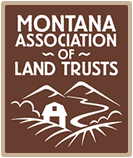Conservation easements have been around in Montana for over 40 years, but there is still some uncertainty about how they work, what they accomplish, and why they have been so successful in Montana.
A conservation easement is the use of a private property right to create a voluntary, negotiated, typically permanent agreement between a landowner and a land trust (or public agency) that limits development and maintains open land.
Simply put: A conservation easement helps the farm and ranch lands stay farm and ranch lands.
Over 2,500 Montana farmers and ranchers have made the decision to place a conservation easement on their property, and there are many different reasons why they have taken that action. A commitment to agricultural conservation and stewardship, a commitment to family farm/ranch legacy and tradition, and potential federal income tax benefits or direct financial compensation are three of those major reasons.
A conservation easement may not be the right fit for every landowner. But thousands of Montana farmers and ranchers have made it—and are making it—work for them and their families.
In fact, thanks to landowner stewardship and support, Montana is a national leader in the number of conservation easements and acres (over 2.6 million acres) conserved by these voluntary agreements.
